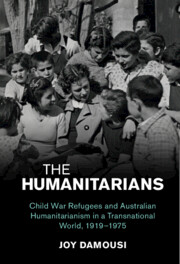 The Humanitarians
The Humanitarians from Part III - Assimilating and Adopting
Published online by Cambridge University Press: 28 July 2022
The themes of adoption, assimilation and whiteness merged on the question of Korean children fathered by Australian servicemen. Chapter 9 examines the vast correspondence between Australians who pleaded with the government to allow adoption of these children. The public response to the predicament of the Japanese–Australian children borne of Australian servicemen and Japanese mothers offers an intriguing narrative of post-war humanitarianism that articulates the beginning of several historic shifts. The first is the paternalistic reaction of the day promoting the traditional nuclear family life after the war, based on the victimhood and dependency of children, and romantic views of blameless childhood innocence. Children were to be ‘saved’, but any suggestion of the rights of the child had not yet entered the popular lexicon, at least not in relation to the campaign surrounding the welfare of these children. The clamour to bring Japanese children to Australia paradoxically also challenged the White Australia policy, as many raised the need for flexibility surrounding this policy to make an exception for the children. Attitudes to the plight of the children also illustrate the collaboration of both religious and secular organisations working together when these organisations did not unite on other issues and were, otherwise, philosophically and politically at odds. Humanitarian causes often brought these and other groups together, but the question of children, I argue, did so unconditionally, and this was the case with the Japanese-Australian children.
To save this book to your Kindle, first ensure [email protected] is added to your Approved Personal Document E-mail List under your Personal Document Settings on the Manage Your Content and Devices page of your Amazon account. Then enter the ‘name’ part of your Kindle email address below. Find out more about saving to your Kindle.
Note you can select to save to either the @free.kindle.com or @kindle.com variations. ‘@free.kindle.com’ emails are free but can only be saved to your device when it is connected to wi-fi. ‘@kindle.com’ emails can be delivered even when you are not connected to wi-fi, but note that service fees apply.
Find out more about the Kindle Personal Document Service.
To save content items to your account, please confirm that you agree to abide by our usage policies. If this is the first time you use this feature, you will be asked to authorise Cambridge Core to connect with your account. Find out more about saving content to Dropbox.
To save content items to your account, please confirm that you agree to abide by our usage policies. If this is the first time you use this feature, you will be asked to authorise Cambridge Core to connect with your account. Find out more about saving content to Google Drive.